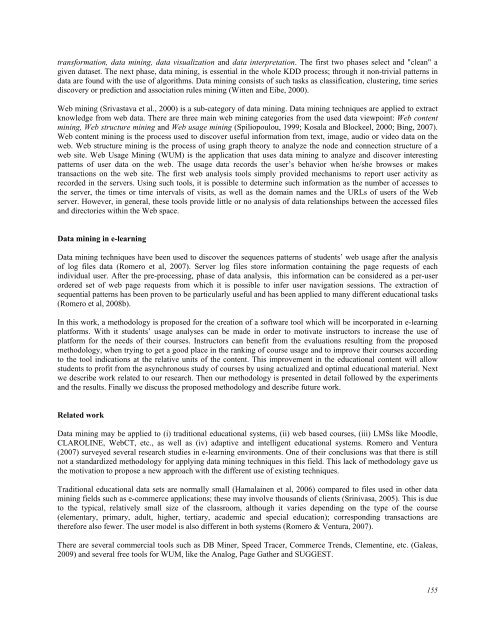April 2012 Volume 15 Number 2 - Educational Technology & Society
April 2012 Volume 15 Number 2 - Educational Technology & Society
April 2012 Volume 15 Number 2 - Educational Technology & Society
You also want an ePaper? Increase the reach of your titles
YUMPU automatically turns print PDFs into web optimized ePapers that Google loves.
transformation, data mining, data visualization and data interpretation. The first two phases select and "clean" a<br />
given dataset. The next phase, data mining, is essential in the whole KDD process; through it non-trivial patterns in<br />
data are found with the use of algorithms. Data mining consists of such tasks as classification, clustering, time series<br />
discovery or prediction and association rules mining (Witten and Eibe, 2000).<br />
Web mining (Srivastava et al., 2000) is a sub-category of data mining. Data mining techniques are applied to extract<br />
knowledge from web data. There are three main web mining categories from the used data viewpoint: Web content<br />
mining, Web structure mining and Web usage mining (Spiliopoulou, 1999; Kosala and Blockeel, 2000; Bing, 2007).<br />
Web content mining is the process used to discover useful information from text, image, audio or video data on the<br />
web. Web structure mining is the process of using graph theory to analyze the node and connection structure of a<br />
web site. Web Usage Mining (WUM) is the application that uses data mining to analyze and discover interesting<br />
patterns of user data on the web. The usage data records the user’s behavior when he/she browses or makes<br />
transactions on the web site. The first web analysis tools simply provided mechanisms to report user activity as<br />
recorded in the servers. Using such tools, it is possible to determine such information as the number of accesses to<br />
the server, the times or time intervals of visits, as well as the domain names and the URLs of users of the Web<br />
server. However, in general, these tools provide little or no analysis of data relationships between the accessed files<br />
and directories within the Web space.<br />
Data mining in e-learning<br />
Data mining techniques have been used to discover the sequences patterns of students’ web usage after the analysis<br />
of log files data (Romero et al, 2007). Server log files store information containing the page requests of each<br />
individual user. After the pre-processing, phase of data analysis, this information can be considered as a per-user<br />
ordered set of web page requests from which it is possible to infer user navigation sessions. The extraction of<br />
sequential patterns has been proven to be particularly useful and has been applied to many different educational tasks<br />
(Romero et al, 2008b).<br />
In this work, a methodology is proposed for the creation of a software tool which will be incorporated in e-learning<br />
platforms. With it students’ usage analyses can be made in order to motivate instructors to increase the use of<br />
platform for the needs of their courses. Instructors can benefit from the evaluations resulting from the proposed<br />
methodology, when trying to get a good place in the ranking of course usage and to improve their courses according<br />
to the tool indications at the relative units of the content. This improvement in the educational content will allow<br />
students to profit from the asynchronous study of courses by using actualized and optimal educational material. Next<br />
we describe work related to our research. Then our methodology is presented in detail followed by the experiments<br />
and the results. Finally we discuss the proposed methodology and describe future work.<br />
Related work<br />
Data mining may be applied to (i) traditional educational systems, (ii) web based courses, (iii) LMSs like Moodle,<br />
CLAROLINE, WebCT, etc., as well as (iv) adaptive and intelligent educational systems. Romero and Ventura<br />
(2007) surveyed several research studies in e-learning environments. One of their conclusions was that there is still<br />
not a standardized methodology for applying data mining techniques in this field. This lack of methodology gave us<br />
the motivation to propose a new approach with the different use of existing techniques.<br />
Traditional educational data sets are normally small (Hamalainen et al, 2006) compared to files used in other data<br />
mining fields such as e-commerce applications; these may involve thousands of clients (Srinivasa, 2005). This is due<br />
to the typical, relatively small size of the classroom, although it varies depending on the type of the course<br />
(elementary, primary, adult, higher, tertiary, academic and special education); corresponding transactions are<br />
therefore also fewer. The user model is also different in both systems (Romero & Ventura, 2007).<br />
There are several commercial tools such as DB Miner, Speed Tracer, Commerce Trends, Clementine, etc. (Galeas,<br />
2009) and several free tools for WUM, like the Analog, Page Gather and SUGGEST.<br />
<strong>15</strong>5

















